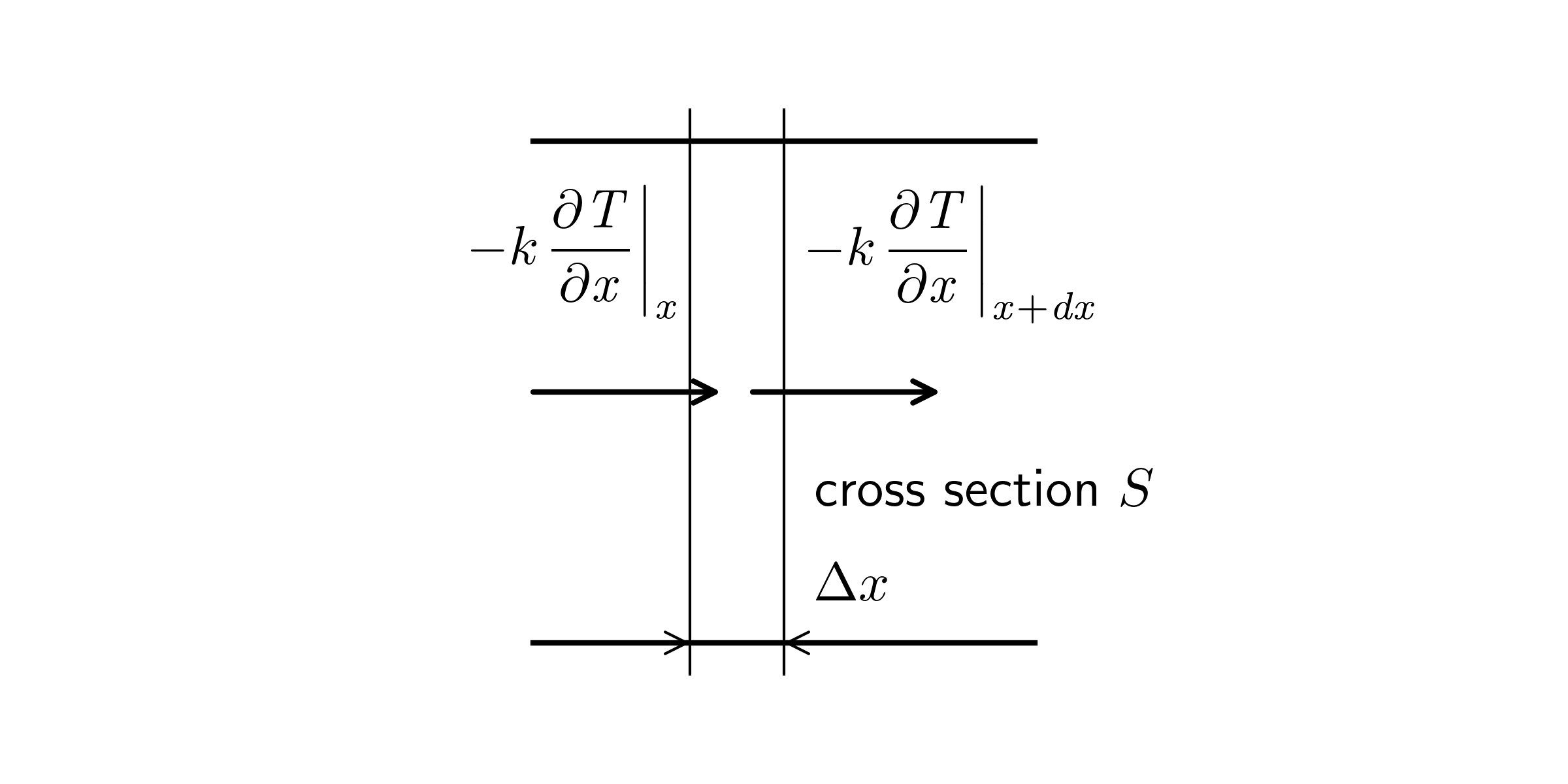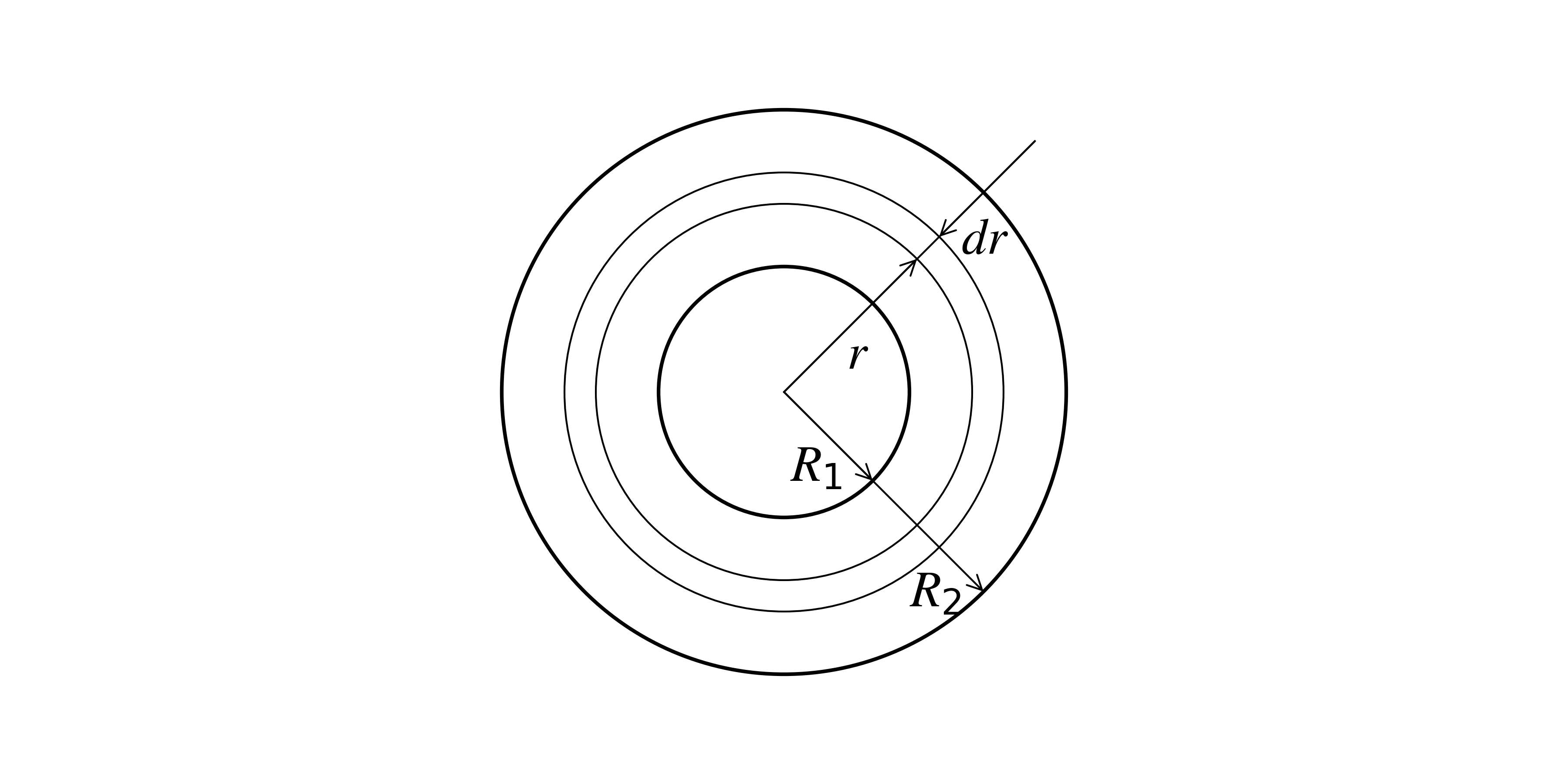| ◀ Previous | TOC | Next ▶ |
Microscopic Balance
Keywords
heat conduction(熱伝導)
Fourier’s law
heat conductivity(熱伝導度)
flux (熱流束)
temperature gradient(温度勾配)
Models with Partial Differential Equations
Change in amount of heat (enthalpy)
We assume that the system is at a constant pressure.
\[\text{(temperature rise)} = \frac{\text{(increase in amount of heat)}}{\text{(heat capacity)}}\]\[\Delta T = \frac{\Delta H}{C_p}\]where the units of the values are \(C_p\) \(\mathrm{[J \ K^{-1}]}\), \(\Delta H\) \(\mathrm{[J]}\), \(\Delta T\) \(\mathrm{[K]}\).
Equivalently,
\[\Delta H = C_p \Delta T\]
For the system with volume \(V\) and density \(\rho\), and the heat capacity per unit mass \(C_p\) \(\mathrm{[J \ K^{-1} \ kg^{-1}]}\)
\begin{align*} & \rho V C_p \frac{\partial T}{\partial t} \\ & = \text{rate of }\left( {\bf input} - {\bf output} + \text{production} - \text{consumption} \right) \end{align*}
Example 1
Consider a steal lod of some length, and suppose we heat up one end of it.
Then, the heat moves from that end toward the other end, and the temperature (distribution) in the lod will change.
Derive the equation describing the local temperature change in the rod from the heat balance.

Example 1, solution
At \(x\)
\[\text{heat flux} = -k \left. \frac{\partial T}{\partial x}\right\vert_x\]the direction is ‘into the system’.
We call \(\left.\frac{\partial T}{\partial x}\right\vert_x\) the heat gradient at \(x\).
At \(x + \Delta x\)
\[\text{heat flux} = - k \left. \frac{\partial T}{\partial x}\right\vert_{x + \Delta x}\]the direction is ‘out of the system’.
Thus,
\[{\bf input} = S \left( - k \left.\frac{\partial T}{\partial x}\right\vert_x\right)\]\[{\bf output} = S \left( - k \left.\frac{\partial T}{\partial x}\right\vert_{x + \Delta x} \right)\]
The balance is
\[(\rho S \Delta x) C_p \frac{\partial T}{\partial t} = - S k \left.\frac{\partial T}{\partial x} \right\vert_x - S\left( - k\left. \frac{\partial T}{\partial x} \right\vert_{x + \Delta x} \right)\]
Taking the limit \(\Delta t \to 0\) and \(\Delta x \to 0\), and we have
\begin{equation} \frac{\partial T}{\partial t} = \frac{k}{\rho C_p} \frac{\partial^2 T}{\partial x^2} \tag{a} \label{eq: heat balance} \end{equation}
Quiz 1
What kind of differential equation is the Eq. \eqref{eq: heat balance}?
Comment
We discuss the method of solution of Eq. \eqref{eq: heat balance} later in this course.
Example 2
Derive the partial differential equation for the radial heat conduction in the pipe. (Radial version of Eq. (a)).

Example 2, solution
内径 \(2R_1\), 外径 \(2R_2\) のパイプに, 中心から半径 \(r\) のところに, 厚さ \(dr\) の微小部分を考える. パイプの長さを \(L\) とすると, この微小部分の体積は \(2 \pi r dr L\) で表される.
半径 \(r\) の位置でのこの微小体積への熱の流入速度は,
\[q = \underbrace{(2\pi rL)}_{\text{面積}}\left( - k \left.\frac{\partial T}{\partial r}\right\vert_r \right)\]半径 \(r+dr\) の位置でこの微小体積からの熱の流出速度は,
\[q = \underbrace{(2\pi (r+ dr) L)}_{\text{面積}}\left( - k \left.\frac{\partial T}{\partial r}\right\vert_{r+dr} \right)\]
伝導物質の密度を \(\rho\), 質量当りの(定圧)熱容量を \(C_p\) とすると, 熱収支より,
\begin{align*} {\rho}{C_p} (2 \pi r drL) \frac{\partial T}{\partial t}& = (2\pi rL)\left( - k \left.\frac{\partial T}{\partial r}\right\vert_r \right) \\ & \quad - {(2\pi (r+ dr) L)}\left( - k \left.\frac{\partial T}{\partial r}\right\vert_{r+dr} \right) \end{align*}
両辺を \(\rho C_p 2 \pi r drL\) で割って整理
\[\frac{\partial T}{\partial t} = \frac{k}{\rho C_p dr} \left( \left. \frac{\partial T}{\partial r} \right\rvert_{r+dr} - \left. \frac{\partial T}{\partial r} \right\rvert_r \right) + \frac{k}{r} \left.\frac{\partial T}{\partial r}\right\rvert_{r+dr}\]\(dr \to 0\) の極限をとって
\[\frac{\partial T}{\partial t}= \frac{k}{\rho C_p} \left(\frac{\partial^2 T}{\partial r^2} + \frac{1}{r} \frac{\partial T}{\partial r} \right)\]
配布資料では, \(\frac{1}{r}\) が \(\frac{2}{r}\) となっていました. 訂正します. (\(\frac{1}{r}\) が正しい).
| ◀ Previous | TOC | Next ▶ |